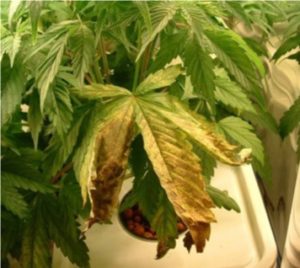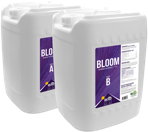Fungal Disease
Share this Post
MANAGING CANNABIS FUNGAL DISEASES
Cannabis plants can be susceptible to a wide range of diseases, including those caused by viruses, bacteria and fungal pathogens. While viral and bacterial diseases are not as prevalent in cannabis as they may be in other crops, fungal diseases present often and with a vengeance. Root and stem rot, bud rot and powdery mildew are three of the most common fungal diseases affecting cannabis.
Fungal diseases that affect foliage and flowers are detrimental to plant growth, but also pose a serious risk for salability of the crop. Flowers that have high mold counts will not pass testing in states that are mandating a minimum for total yeast and mold count. Fungal diseases affecting the roots of young clones or seedlings can wipe out an entire crop before it even develops into the flowering stage. Understanding the potential diseases and implementing an effective integrated pest management protocol is essential in the prevention of these crop killers.
STEM AND ROOT ROT
 There are multiple pathogens responsible for causing stem and root rot diseases, but the Pythium pathogen is one of the most common culprits seen in horticulture. There are over 100 species of Pythium, but not all are pathogenic. The pathogenic varieties can cause root and stem rot, causing the symptoms of brown, slimy roots and the stem “damping off.” These pathogens may also create symptoms that look like nitrogen deficiency and stunted and/or wilted plants.
There are multiple pathogens responsible for causing stem and root rot diseases, but the Pythium pathogen is one of the most common culprits seen in horticulture. There are over 100 species of Pythium, but not all are pathogenic. The pathogenic varieties can cause root and stem rot, causing the symptoms of brown, slimy roots and the stem “damping off.” These pathogens may also create symptoms that look like nitrogen deficiency and stunted and/or wilted plants.
 Pythium also causes root lesions that increase susceptibility to other pathogens, leading to multiple infections at once. These spores are carried through water, thrive in wet, alkaline soil conditions and are attracted to root exudates. Overfertilizing weakens cell walls and increases root exudates, increasing susceptibility. Recirculating hydroponic systems are at the greatest risk for spreading the pathogen.
Pythium also causes root lesions that increase susceptibility to other pathogens, leading to multiple infections at once. These spores are carried through water, thrive in wet, alkaline soil conditions and are attracted to root exudates. Overfertilizing weakens cell walls and increases root exudates, increasing susceptibility. Recirculating hydroponic systems are at the greatest risk for spreading the pathogen.
BUD ROT
 Bud rot, or grey mold, is often caused by Botrytis cinerea, a very common mold pathogen that affects over 500 plant species. It thrives on cool, wet foliage, and spores can overwinter on plant debris and in soil. It spreads
Bud rot, or grey mold, is often caused by Botrytis cinerea, a very common mold pathogen that affects over 500 plant species. It thrives on cool, wet foliage, and spores can overwinter on plant debris and in soil. It spreads
quickly when heat and humidity are high. This mold invades the tight spaces between buds of cannabis flowers, often going unnoticed until a cola is broken open. Botrytis is systemic and can be spread through seeds. Very large, dense buds are highly susceptible to infection.
POWDERY MILDEW
 One of the most common fungal diseases affecting cannabis, Golovinomyces, or powdery mildew, spreads along the surface of leaves or within the plant’s vascular system. Cool, cloudy and humid conditions favor spore growth. However, hot and dry conditions create susceptible plants, so climate control is essential to prevent the growth and spread of powdery mildew.
One of the most common fungal diseases affecting cannabis, Golovinomyces, or powdery mildew, spreads along the surface of leaves or within the plant’s vascular system. Cool, cloudy and humid conditions favor spore growth. However, hot and dry conditions create susceptible plants, so climate control is essential to prevent the growth and spread of powdery mildew.
Weed management and good sanitation are important practices to prevent the spread of powdery
mildew. Spores overwinter on dead plant material and survive in affected plants. Grasses are a host to
powdery mildew and can harbor spores for years.
FUNGAL DISEASE CONTROLS
Stagnant air, low light conditions and poor ventilation create an ideal environment for mold spores to reproduce. Many fungal pathogens are spread through contaminated soil or water, and can lay dormant for years in soil, weeds and decaying plant material. Prevention is the most effective cure for fungal pathogens. This begins with cultural management practices that eliminate the ideal environment for the growth of pathogens. The use of chemical (synthetic or natural) controls should also be included in a pest management program.
Cultural pest management requires a good sanitation program, monitoring soil moisture and soluble salt content, and maintaining optimal climate conditions such as plant spacing and adequate air flow. Remove waste plant material and weeds from grow areas, avoid overwatering and overfertilizing, and immediately cull sick or damaged plants as part of cultural management practices.
Chemical pest management for fungal diseases includes the use of products with fungicidal properties. Cannabis cultivation in most regulated markets prohibits the use of synthetic fungicides, but there are several other options available to producers. Potassium bicarbonate is an effective control for powdery mildew and botrytis. Hydrogen peroxide is a valuable addition to nutrient reservoirs to control biofilm and pathogenic fungi. Many studies have found that plant-extracted essential oils work very well as contact fungicides and have shown to be highly effective at controlling many pathogens, including Pythium, Botrytis and Golovinomyces. Among the plant-extracted oils studied for fungicidal properties, cinnamon oil and thyme oil show some of the highest level of efficacy when compared to chemical fungicides.
Plant-extracted essential oils prove to be a better choice for inclusion in IPM protocols than chemical fungicides, providing a broader spectrum of target pathogens and an equal or superior level of efficacy to many synthetic alternatives. The added benefit of lower risk of phytotoxicity and exposure risk for applicators makes an essential oil-based product an easy choice for conscious growers.

